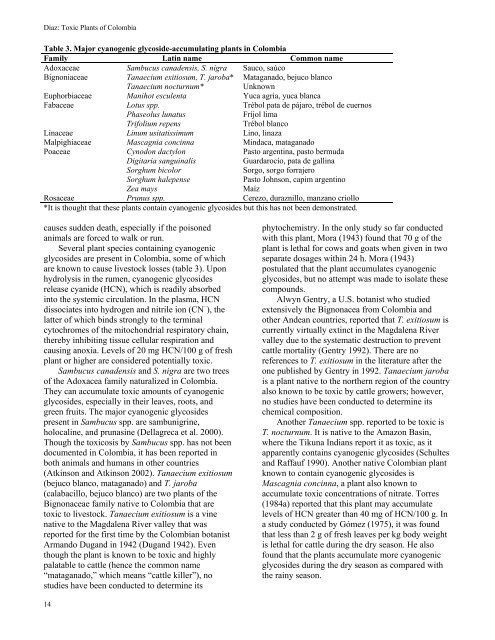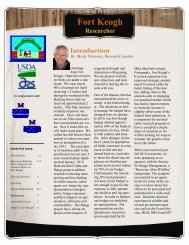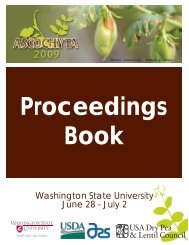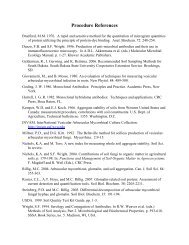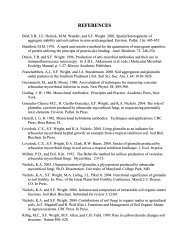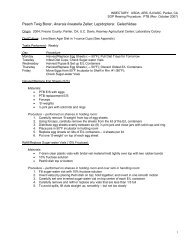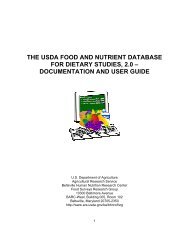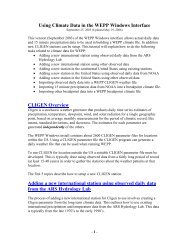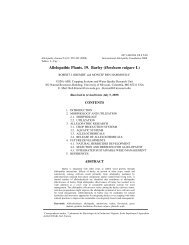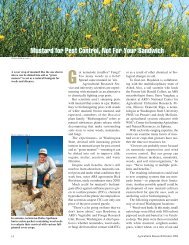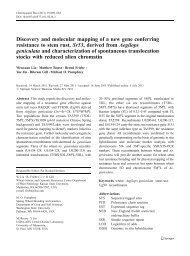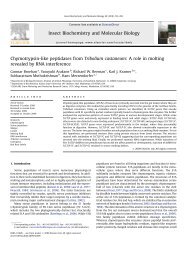International Journal of Poisonous Plant Research - Agricultural ...
International Journal of Poisonous Plant Research - Agricultural ...
International Journal of Poisonous Plant Research - Agricultural ...
You also want an ePaper? Increase the reach of your titles
YUMPU automatically turns print PDFs into web optimized ePapers that Google loves.
Diaz: Toxic <strong>Plant</strong>s <strong>of</strong> Colombia<br />
Table 3. Major cyanogenic glycoside-accumulating plants in Colombia<br />
Family Latin name Common name<br />
Adoxaceae Sambucus canadensis, S. nigra Sauco, saúco<br />
Bignoniaceae Tanaecium exitiosum, T. jaroba* Mataganado, bejuco blanco<br />
Tanaecium nocturnum* Unknown<br />
Euphorbiaceae Manihot esculenta Yuca agria, yuca blanca<br />
Fabaceae Lotus spp. Trébol pata de pájaro, trébol de cuernos<br />
Phaseolus lunatus Fríjol lima<br />
Trifolium repens Trébol blanco<br />
Linaceae Linum usitatissimum Lino, linaza<br />
Malpighiaceae Mascagnia concinna Mindaca, mataganado<br />
Poaceae Cynodon dactylon Pasto argentina, pasto bermuda<br />
Digitaria sanguinalis Guardarocío, pata de gallina<br />
Sorghum bicolor Sorgo, sorgo forrajero<br />
Sorghum halepense Pasto Johnson, capim argentino<br />
Zea mays Maíz<br />
Rosaceae Prunus spp. Cerezo, duraznillo, manzano criollo<br />
*It is thought that these plants contain cyanogenic glycosides but this has not been demonstrated.<br />
causes sudden death, especially if the poisoned<br />
animals are forced to walk or run.<br />
Several plant species containing cyanogenic<br />
glycosides are present in Colombia, some <strong>of</strong> which<br />
are known to cause livestock losses (table 3). Upon<br />
hydrolysis in the rumen, cyanogenic glycosides<br />
release cyanide (HCN), which is readily absorbed<br />
into the systemic circulation. In the plasma, HCN<br />
dissociates into hydrogen and nitrile ion (CN – ), the<br />
latter <strong>of</strong> which binds strongly to the terminal<br />
cytochromes <strong>of</strong> the mitochondrial respiratory chain,<br />
thereby inhibiting tissue cellular respiration and<br />
causing anoxia. Levels <strong>of</strong> 20 mg HCN/100 g <strong>of</strong> fresh<br />
plant or higher are considered potentially toxic.<br />
Sambucus canadensis and S. nigra are two trees<br />
<strong>of</strong> the Adoxacea family naturalized in Colombia.<br />
They can accumulate toxic amounts <strong>of</strong> cyanogenic<br />
glycosides, especially in their leaves, roots, and<br />
green fruits. The major cyanogenic glycosides<br />
present in Sambucus spp. are sambunigrine,<br />
holocaline, and prunasine (Dellagreca et al. 2000).<br />
Though the toxicosis by Sambucus spp. has not been<br />
documented in Colombia, it has been reported in<br />
both animals and humans in other countries<br />
(Atkinson and Atkinson 2002). Tanaecium exitiosum<br />
(bejuco blanco, mataganado) and T. jaroba<br />
(calabacillo, bejuco blanco) are two plants <strong>of</strong> the<br />
Bignonaceae family native to Colombia that are<br />
toxic to livestock. Tanaecium exitiosum is a vine<br />
native to the Magdalena River valley that was<br />
reported for the first time by the Colombian botanist<br />
Armando Dugand in 1942 (Dugand 1942). Even<br />
though the plant is known to be toxic and highly<br />
palatable to cattle (hence the common name<br />
“mataganado,” which means “cattle killer”), no<br />
studies have been conducted to determine its<br />
14<br />
phytochemistry. In the only study so far conducted<br />
with this plant, Mora (1943) found that 70 g <strong>of</strong> the<br />
plant is lethal for cows and goats when given in two<br />
separate dosages within 24 h. Mora (1943)<br />
postulated that the plant accumulates cyanogenic<br />
glycosides, but no attempt was made to isolate these<br />
compounds.<br />
Alwyn Gentry, a U.S. botanist who studied<br />
extensively the Bignonacea from Colombia and<br />
other Andean countries, reported that T. exitiosum is<br />
currently virtually extinct in the Magdalena River<br />
valley due to the systematic destruction to prevent<br />
cattle mortality (Gentry 1992). There are no<br />
references to T. exitiosum in the literature after the<br />
one published by Gentry in 1992. Tanaecium jaroba<br />
is a plant native to the northern region <strong>of</strong> the country<br />
also known to be toxic by cattle growers; however,<br />
no studies have been conducted to determine its<br />
chemical composition.<br />
Another Tanaecium spp. reported to be toxic is<br />
T. nocturnum. It is native to the Amazon Basin,<br />
where the Tikuna Indians report it as toxic, as it<br />
apparently contains cyanogenic glycosides (Schultes<br />
and Raffauf 1990). Another native Colombian plant<br />
known to contain cyanogenic glycosides is<br />
Mascagnia concinna, a plant also known to<br />
accumulate toxic concentrations <strong>of</strong> nitrate. Torres<br />
(1984a) reported that this plant may accumulate<br />
levels <strong>of</strong> HCN greater than 40 mg <strong>of</strong> HCN/100 g. In<br />
a study conducted by Gómez (1975), it was found<br />
that less than 2 g <strong>of</strong> fresh leaves per kg body weight<br />
is lethal for cattle during the dry season. He also<br />
found that the plants accumulate more cyanogenic<br />
glycosides during the dry season as compared with<br />
the rainy season.


